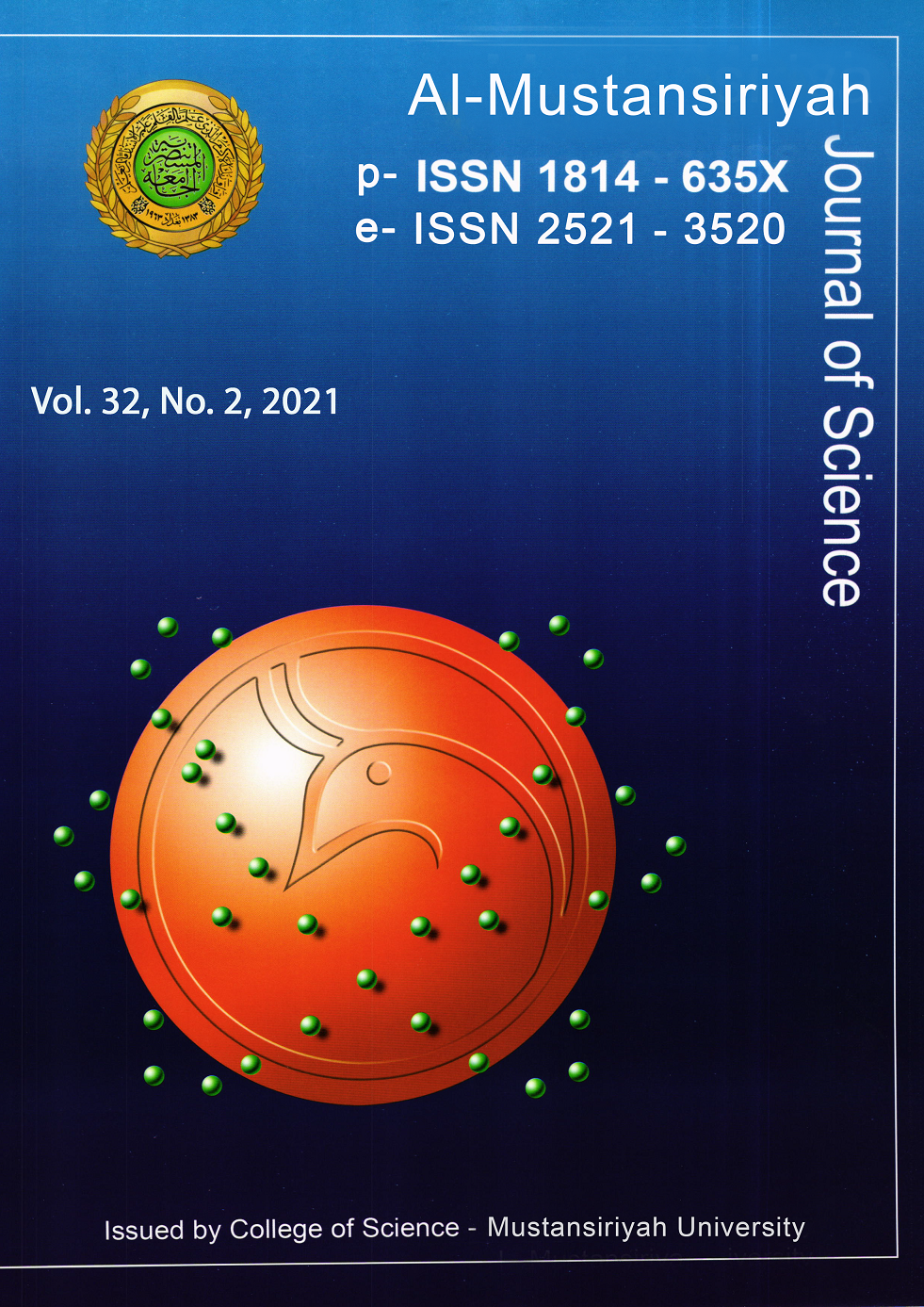Study Effect of Some Atmospheric Elements on COVID-19 Infections in Iraq
DOI:
https://doi.org/10.23851/mjs.v32i2.987Keywords:
COVID-19, temperature differences, relative humidity, Iraq provinces, RelationshipAbstract
In late 2019 and in Wuhan, a new disease appears, consider as an extension of SARS-COV2 epidemic. This epidemic virus has configured a danger to global health. We studied the effect of some atmospheric elements in Iraq with a number of (COVID-19) infections. In this study daily infections in three regions of Iraq compares with (Tmax-Tmin) and (RH) observed in stations Mosul (represent north region), Baghdad and Rutba (represent middle regions), and Basra (represent south region). It's found that increasing the difference between Tmax and Tmin means more infections, except for the northern province. As for the relative humidity, it is inversely proportional to infections with the correlation coefficient R = -0.6 in Baghdad station, and in the southern province with R = -0.32, and the opposite occurs in the northern province. The results also indicate that increasing the relative humidity to more than 70% was effective in increasing the infections. Solar radiation was studied over the city of Baghdad and its effect on infections because solar radiation contains a large proportion of ultraviolet rays that killed many viruses, the study indicates an inverse relationship because most of the patients are infected in the shade and there is no clear relationship. In late 2019 and in Wuhan, a new decease appears, consider as extension of SARS-COV2 epidemic. This epidemic virus has configured a danger on the global health. We studied the effect of some atmospheric elements in Iraq with number of (COVID-19) infections. At this study daily infections in three regions of Iraq compare with (Tmax-Tmin) and (RH) observed in stations Mosul (represent north region), Baghdad and Rutba (represent middle regions) and Basra (represent south region). It's found that increasing the difference between Tmax and Tmin means more infections, except for the northern province. As for the relative humidity it is inversely proportional to infections with the correlation coefficient R = -0.6 in Baghdad station, and in the southern province with R = -0.32, and the opposite occurs in the northern province. The results also indicate that increasing the relative humidity to more than 70% was effective in increasing the infections. Solar radiation was studied over the city of Baghdad and its effect on infections because solar radiation contains a large proportion of ultraviolet rays that killed many viruses, the study indicates an inverse relationship because most of the patients are infected in the shade and there is no clear relationship.Downloads
References
H. M. Al-Kuraishy and A. I. Al-Gareeb, "From SARS-CoV2 to nCoV-2019: Ruction and Argument," Arch. Clin. Infect. Dis., vol. In Press, no. In Press, 2020, pp. 13-16, doi: 10.5812/archcid.102624.
N. S. Zhong et al., "Epidemiology and cause of severe acute respiratory syndrome (SARS) in Guangdong, People's Republic of China, in February, 2003," Lancet, vol. 362, no. 9393, 2003, pp. 1353-1358, doi: 10.1016/S0140-6736(03)14630-2.
V. Common-, "SARS-Associated Coronavirus" , 2003, pp. 1948-1951.
Q. Li et al., "Early Transmission Dynamics in Wuhan, China, of Novel Coronavirus-Infected Pneumonia," N. Engl. J. Med., vol. 382, no. 13, 2020, pp.1199-1207, doi:10.1056/NEJMoa2001316.
H. Abdul, S. Hashmi, and H. M. Asif, "EARLY DETECTION OF COVID-19," 2020.
et al. Davis, Robert E., "Cold, dry air is associated with influenza and pneumonia mortality in Auckland, New Zealand," Influenza Other Respi. Viruses, vol. 10, no. 4, 2016, pp. 310-313.
P. P. . Lowen AC, Mubareka S, Steel J, "Influenza virus transmission is dependent on relative humidity and temperature.," Plos Pathog, vol. 3, no. 10, 2007,pp. 1470-1476.
S. B. Shaman J, Kohn M, "Absolute Humidity Modulates Influenza Survival, Transmission, and Seasonality," P Natl Acad Sci Usa, vol. 106, no. 9, 2009, pp. 3243-3248.
xiaohang wen, C. Liu, B. Cao, S. Wang, Y. Zhang, and R. Zhong, "Relationship between the COVID-19 Outbreak and Temperature, Humidity, and Solar Radiation Across China," SSRN Electron. J., 2020, doi: 10.2139/ssrn.3594115.
F. S. Cohen, "How Viruses Invade Cells," Biophys. J., vol. 110, no. 5, 2016, pp.1028-1032, doi: 10.1016/j.bpj.2016.02.006.
F. Fasina et al., "Non-Attenuation Of Highly Pathogenic Avian Influenza H5N1 By Laboratory Exposure To Ultraviolet Rays," African J. Clin. Exp. Microbiol., vol. 11, no. 1, 2009, pp.2-8, doi: 10.4314/ajcem.v11i1.44085.
J. L. Sagripanti and C. D. Lytle, "Inactivation of influenza virus by solar radiation," Photochem. Photobiol., vol. 83, no. 5, 2007, pp. 1278-1282, doi: 10.1111/j.1751-1097.2007.00177.x.
J. J. Cannell et al., "Epidemic influenza and vitamin D," Epidemiol. Infect., vol. 134, no. 6, 2006, pp. 1129-1140, doi: 10.1017/S0950268806007175.
M. Urashima, T. Segawa, M. Okazaki, M. Kurihara, Y. Wada, and H. Ida, "Randomized trial of vitamin D supplementation to prevent seasonal influenza A in schoolchildren," Am. J. Clin. Nutr., vol. 91, no. 5, 2010, pp. 1255-1260, doi: 10.3945/ajcn.2009.29094.
J. Tamerius et al., "All use subject to JSTOR Terms and Conditions Review Global Influenza Seasonality : Reconciling Patterns across Temperate and," vol. 119, no. 4, 2014, pp. 439-445, doi: 10.1289/ehp.2010.
M. H. Khudur, "Effect of Dust Storm on Solar Radiation over Iraq," Al-Mustansiriyah University, Iraq, 2014.
J. E. W. a. O. Gerald Henry Blake, "Iraq. December 30, ; Available from:,"2019. https://www.britannica.com/place/Iraq.
Downloads
Key Dates
Received
Accepted
Published
Issue
Section
License
Copyright (c) 2021 Al-Mustansiriyah Journal of Science

This work is licensed under a Creative Commons Attribution 4.0 International License.
(Starting May 5, 2024) Authors retain copyright and grant the journal right of first publication with the work simultaneously licensed under a Creative Commons Attribution (CC-BY) 4.0 License that allows others to share the work with an acknowledgement of the work’s authorship and initial publication in this journal.






















